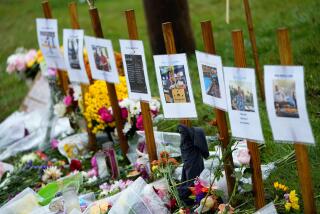Marines’ Handling of Colonel’s Death Hit
- Share via
EL TORO — The family of a top Marine who apparently killed himself is making new charges that the military botched its investigation into the colonel’s controversial 1991 death and may have doctored photographs at the death scene.
Col. James E. Sabow’s survivors filed a $60-million claim against the military last November, nearly two years after Sabow’s death during a scandal over the use of government planes that led to the dismissal of the commanding general at the Marine Corps Air Station at El Toro.
Now, the Sabow family has raised new allegations against the military, saying that officials rearranged key evidence at the scene of Sabow’s death, lost fingerprints, and failed to cordon off the site for hours.
Family members have claimed that the colonel may have been murdered because of what he knew about the widening issue of plane misuse. Their legal brief, filed with the military Jan. 22, never addresses that question directly, but it does seek to punch holes in the military’s explanation of what happened to Sabow.
“The incompetence and inadequacy of the investigations which resulted in the loss, obliteration and contamination of evidence has, perhaps, made it impossible to establish the true circumstances of Col. Sabow’s death,” according to the documents.
Marine officials at El Toro declined comment on the allegations Monday.
Sabow, 51, an assistant chief of staff at El Toro, was found dead in the back yard of his base home on Jan. 22, 1991. Military investigators concluded that he had killed himself with a .12-gauge, double-barreled shotgun.
Sabow and the chief of staff at El Toro, Col. Joseph E. Underwood, had been suspended for allegedly taking base planes for golfing jaunts and other non-military trips around the country.
The Times later disclosed that the military officer who suspended them, Brig. Gen. Wayne T. Adams, had himself used base planes to travel to Florida to sign his divorce papers, visit his fiancee, and take other personal trips. The disclosures led to Adams’ dismissal as commander of the Marines’ western air bases.
Sabow’s family has denied that he did anything to warrant the suspension.
“The military let this man down before his death, and they’ve let his family down after his death,” said John David Sabow, a South Dakota neurologist and the colonel’s brother, who said family members have spent $100,000 on the case.
The military has until April to rule on the Sabow family’s claim. If it is rejected, the Sabows would then be able to pursue a civil suit against the military in U.S. District Court.
Potentially, the family’s most damaging allegation centers on photographs taken at the death scene.
The brief maintains that when investigators first arrived at the scene, they found Sabow’s body lying on its right side, with a lawn chair tipped over two to three feet behind him.
But photographs taken by investigators and given to the Sabows show the chair lying on top of Sabow, the claim alleges. The Sabows maintain that military personnel rearranged the chair and the body “in attempting to re-create what had happened,” the brief says.
Gene Wheaton, a former Army investigator who is working as a consultant for the Sabows, said, “It’s improper conduct to go in and dummy up a site and take pictures of things that were not the way you found them.”
The claim also alleges that a Naval Investigative Service agent grasped the shotgun that killed Sabow, thus tainting the evidence. And investigators waited several hours before sealing off the Sabow home, allowing a myriad of military personnel access to the scene, the documents claim.
More to Read
Sign up for Essential California
The most important California stories and recommendations in your inbox every morning.
You may occasionally receive promotional content from the Los Angeles Times.













